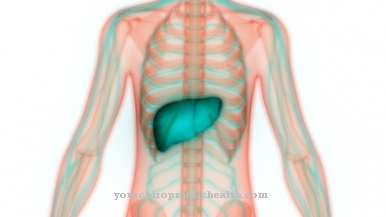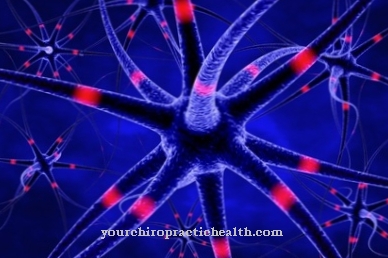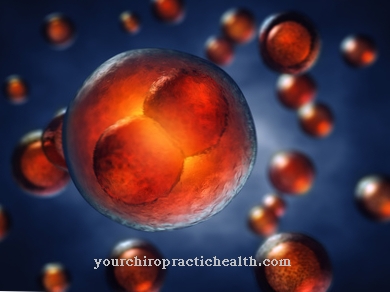Of the Anabolism describes building metabolic processes in the organism. Anabolic and catabolic metabolic processes are closely linked. A structure of matter always consumes energy.
What is anabolism?

Anabolism and catabolism are always linked to one another in the metabolic processes. Anabolism characterizes the build-up of energy-rich and complex compounds from simple molecules with the supply of energy. In plants, photosynthesis is an anabolic metabolic process. Simple compounds such as water, carbon dioxide and minerals are converted into carbohydrates, proteins and fats with the help of solar energy.
However, not only in plants, but also in animal and human organisms, anabolic metabolic processes are constantly taking place. The term anabolism is sometimes vaguely defined. However, the establishment of connections under energy consumption emerges as a common criterion of the definition.
Energy-rich complex molecules such as carbohydrates, proteins and fats are also built up in the animal and human organism while consuming energy. At the same time, however, humans and animals first ingest carbohydrates, proteins and fats with their food, which are broken down with the release of energy. These catabolic metabolic processes generate energy for life processes and at the same time, in addition to water and carbon dioxide, also simple organic breakdown products, such as pyruvate, which can be used again as starting materials for the construction of the body's own substances. However, this requires energy that is obtained from the catabolic metabolic processes and transferred to the new compounds via the intermediate energy store ATP.
Function & task
Anabolism is indispensable for the organism. In a narrower sense, anabolism means the build-up of muscle proteins. However, it refers to all building processes that produce the body's own proteins, fats and carbohydrates. It doesn't always have to be complex connections. The new synthesis of a glucose molecule from the intermediate pyruvate is already an anabolic process. Because this requires energy.
The structure of the body's own substances should serve to build up the structure and growth of the body on the one hand and to store energy on the other. To build up the body, proteins and their basic building blocks, the amino acids, are mainly required. The amino acids come from the breakdown processes of the proteins ingested with food.
As part of an anabolic process, the individual amino acids are reassembled into the body's own proteins. Amino acids that are not required are further converted into simple compounds such as carbon dioxide, water, urea or metabolites such as pyruvate. Pyruvate can be broken down further or used as a starting compound for the formation of glucose, amino acids or fatty acids. In this way, it is possible for amino acids to be converted into glucose. Catabolic and anabolic processes are linked to one another.
Glucose can be stored in the polymeric storage form glucogen in the liver and muscles. Glucogen serves as a potential energy store when needed. The newly formed fatty acids can be converted into fat by esterification with glycerine, which is stored in the adipocytes as an energy reserve.
All building processes require energy, which is made available by the energy buffer ATP. ATP always arises from ADP through a further bond of a phosphate group while absorbing energy. This energy comes from catabolic metabolic processes.
The complex metabolic processes in the body are controlled by hormones. There are hormones that tend to promote catabolism, such as the thyroid hormones, or hormones that promote anabolism.These include insulin, growth hormones or sex hormones. Anabolic processes can also cause catabolic processes and vice versa. For example, building muscle promotes fat loss. On the other hand, muscle loss is often associated with fat gain.
Illnesses & ailments
Diseases related to anabolism are often caused by hormonal imbalances. The hormonal disorders can be caused by both internal and external causes. A well-known example of an external cause is anabolic steroids abuse. Anabolic steroids are often used by competitive and strength athletes to promote muscle growth. They are hormone-like substances or even hormones.
A commonly used anabolic steroid is the male sex hormone testosterone. Testosterone promotes muscle building in both men and women. However, many consequential damages have become known. In men, the constant use of hormones reduces the production of endogenous testosterone. After stopping the anabolic, there is a rapid drop in performance and muscle breakdown. The body's own hormone synthesis is no longer stimulated. Among other things, there are testosterone deficiency with poor performance, breast enlargement in men, psychological problems, degradation of the skeletal and musculoskeletal system, increased risk of heart attack and stroke, liver damage and shrunken testicles with the development of infertility. In women, the menstrual cycle can be disturbed. The clitoris also enlarges.
If the anabolism is disturbed by internal causes, disturbances of the hormonal balance often play a role. These can be hereditary or caused by serious diseases of the hormone-producing glands. Typical examples are the deficiency and overproduction of the growth hormone somatropin. If there is already a somatropin deficiency in childhood, short stature results.
Overproduction leads to giant growth and in adulthood to acromegaly, which is associated with excessive growth of the hands, feet, ears, nose, chin or external genitals. In the case of underactive adulthood, increased muscle and bone loss results. At the same time, however, the fatty tissue increases.
In the so-called Cushing's syndrome, the body's own proteins are also increasingly broken down. At the same time, however, fat builds up in the form of trunk obesity. Here the hormone cortisol is increased, which promotes the conversion of amino acids into glucose.



























